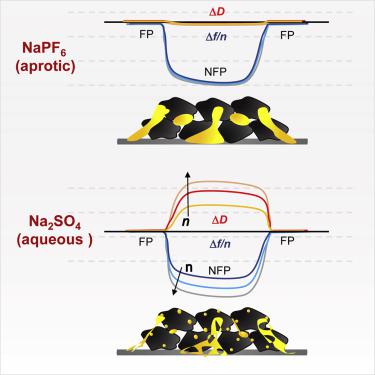Joule ( IF 39.8 ) Pub Date : 2018-03-13 , DOI: 10.1016/j.joule.2018.02.014 Netanel Shpigel , Sergey Sigalov , Mikhael D. Levi , Tyler Mathis , Leonid Daikhin , Alar Janes , Enn Lust , Yury Gogotsi , Doron Aurbach

|
The high phase-transformation strain developed upon intercalation in the host particles of a composite battery electrode affects the polymeric binder network mechanically, deteriorating the electrode cycling performance. Here, electrochemical quartz crystal microbalance with dissipation monitoring (EQCM-D) is used to demonstrate a new strain-accommodation mechanism, in high-strain NaFePO4/PVdF electrodes, via relaxation of the binder network surrounding the intercalation particles. Complete mechanical degradation of the polymer network occurs during long-term cycling of NaFePO4 electrodes in aqueous solutions (hard and tough behavior). In contrast, in aprotic solutions, a softened binder easily accommodates the high transformation strain, ensuring excellent electrode cycling performance (soft and tough behavior). Quantification of the high-frequency viscoelastic properties of an operating composite electrode linked to the binder's fracture toughness ensures fast and facile screening of the optimal polymeric binder/electrolyte solution combinations. This methodology should be extremely important for optimization of cycling performance of Li-Si anodes undergoing huge volume changes during cycling.
中文翻译:

电池电极中粒子与粘合剂相互作用的原位声学诊断
当插入复合电池电极的主体颗粒中时产生的高相变应变会机械地影响聚合物粘合剂网络,从而降低电极循环性能。在这里,具有耗散监测功能的电化学石英晶体微天平(EQCM-D)用于通过松弛嵌入层周围的粘合剂网络,在高应变NaFePO 4 / PVdF电极中展示一种新的应变适应机制。NaFePO 4的长期循环过程中会发生聚合物网络的完全机械降解水溶液中的电极(坚硬的行为)。相反,在非质子溶液中,软化的粘合剂容易适应高相变应变,从而确保出色的电极循环性能(柔软而坚韧的行为)。与粘合剂的断裂韧性有关的可操作复合电极的高频粘弹性的定量可确保快速,简便地筛选最佳的聚合物粘合剂/电解质溶液组合。这种方法对于优化锂-硅阳极在循环过程中经历巨大体积变化的循环性能至关重要。

























 京公网安备 11010802027423号
京公网安备 11010802027423号